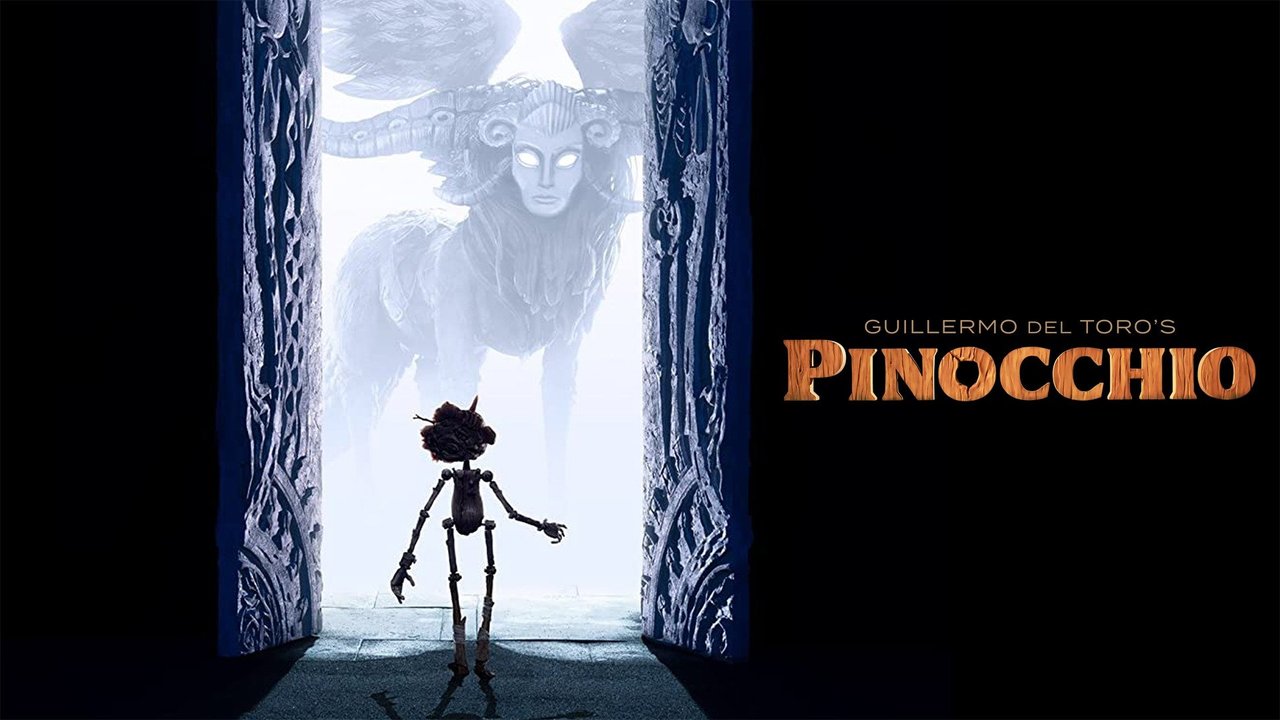Welcome to our Colossus Movie Guide for Guillermo del Toro’s Pinocchio. This guide contains everything you need to understand the film. Dive into our detailed library of content, covering key aspects of the movie. We encourage your comments to help us create the best possible guide. Thank you!
What is Guillermo del Toro’s Pinocchio about?
Guillermo del Toro’s Pinocchio is thematically wide-ranging but primarily emphasizes companionship, grief, kindness, time, and mortality. We witness Pinocchio go from a maniacal, indulgent newborn to a gentle, thoughtful soul. There’s something very peaceful about the film’s conclusion that somehow takes the terror out of death and turns it into a gentle, well-earned rest. Beneath the superficial aspects of the plot, there’s a lot about what it means and takes to live a good life. And that time is a very valuable thing. This movie may come and go for the average adult. But it will definitely be a landmark, instructive experience for a number of kids. Similar to the way The Land Before Time and The Lion King both prepared a generation to process tragedy, loss, and grief.
Movie Guide table of contents
Cast
- Pinocchio – Gregory Mann
- Carlo – Gregory Mann
- Geppetto – David Bradley
- Sebastian J. Cricket – Ewan McGregor
- Count Volpe – Christoph Waltz
- Spazzatura – Cate Blanchett
- Podestà – Ron Perlman
- Candlewick – Finn Wolfhard
- The Wood Sprite – Tilda Swinton
- Death – Tilda Swinton
- Written by – Guillermo del Toro, Patrick McHale
- Directed by – Guillermo del Toro, Mark Gustafson
The ending of Guillermo del Toro’s Pinocchio explained
Recap
Pinocchio has three final sequences. The beach scene. The return home. And Sebastian’s J. Cricket’s card playing in the afterlife.
The beach scene is the aftermath of the escape from the sea monster whale. To defeat this monster, Pinocchio detonates a naval mine. It works, but Pinocchio dies in the process. He appears in the afterlife and urges death to let him go back immediately so he can save Geppetto and the others. Even though Pinocchio doesn’t have to wait long, every second counts. The cost of returning early is the loss of Pinocchio’s immortality. He’ll awaken mortal. He takes the deal, awakens, and, with only one arm, manages to save Geppetto from drowning. Unfortunately, in the process, Pinocchio drowns.
During the beach scene, the Wood Sprite returns. Sebastian J. Cricket uses the wish Wood Sprite promised him to resurrect Pinocchio. Everyone is happy. The newly forged family returns to Geppetto’s cottage where they spend their days in peace and joy. Geppetto passes. Sebasian. And lastly Spazzatura. Pinocchio visits their graves. Then goes off into the world. Sebastian narrates, “What happens, happens. And then we are gone” as a pinecone falls from a tree branch.
One final moment interrupts the beginning of the credits. It’s Sebastian in the afterlife, playing cards with a bunch of skeletal rabbits. After they interrupt him, he says, “Do you mind? I was recounting my life!” To which a rabbit says, “It was a good life.” Sebastian responds, “Ah, good enough.” Then commences a dance number that plays out through the credits.
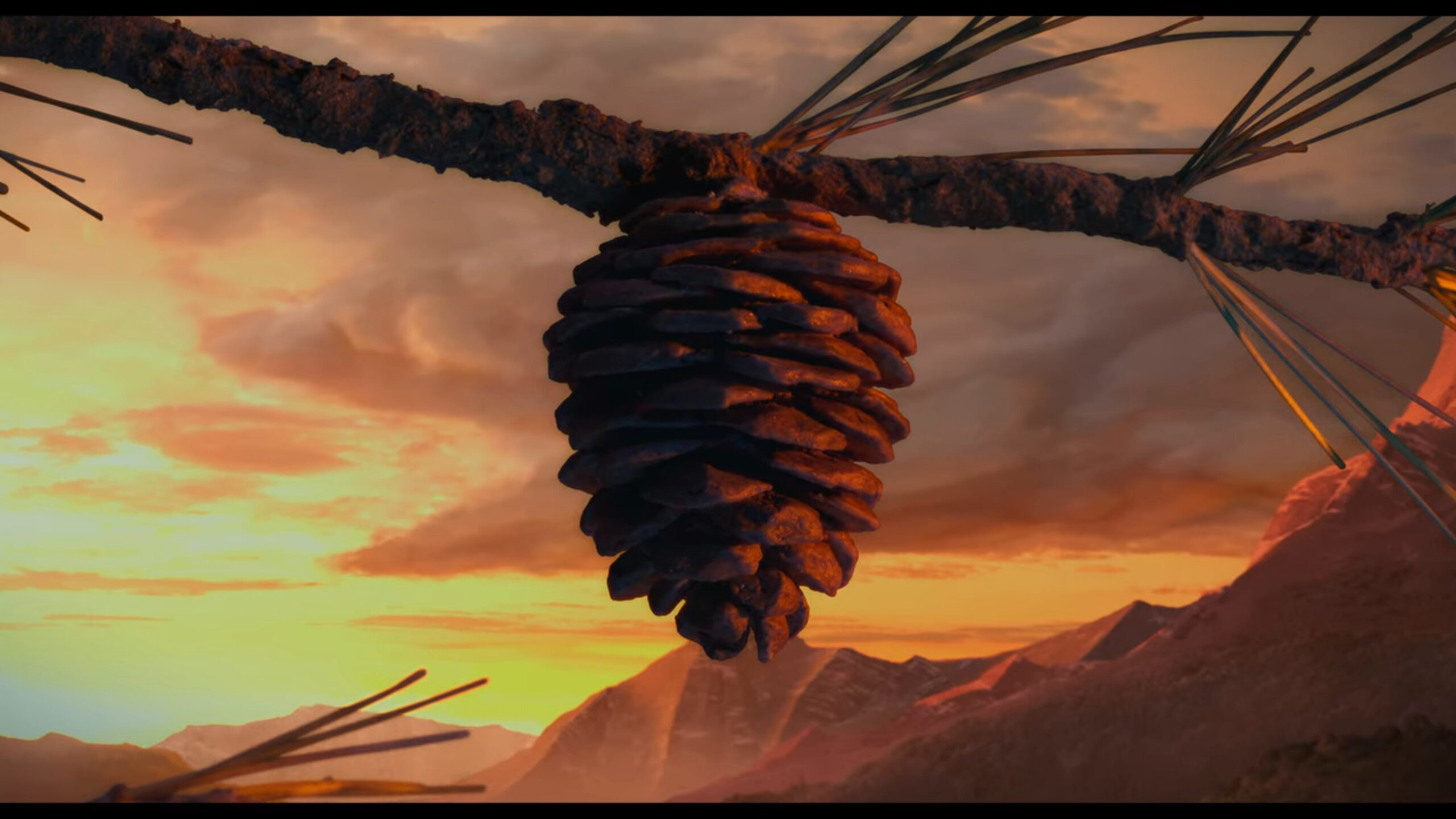
Meaning
As much as Guillermo del Toro’s Pinocchio is about many things, it emphasizes appreciating a decent life. Geppetto had a happy, simple life with Carlo. Then lost Carlo and lost his happy, simple life. When Pinocchio first wakes up, he’s pretty crazy. And selfish. And can’t appreciate the simple. Which is why he’s lured away by the idea of fame and everything fame promises. It’s exactly that experience and how horrible it is that allows Pinocchio to appreciate simply spending time with Geppetto, Sebastian, and Spazzatura.
The character arc of Sebastian reinforces this point. Sebastian begins the movie as this self-interested wanna-be writer. When the Wood Sprite tells him she’ll eventually grant a wish for him, his first reflections are, “And that could be anything? The publication of my book? Fame? Fortune?” He too is interested in something grander than the simple. But when it comes time to make his wish, its for Pinocchio’s life.
The key key key thing is that last line, in the afterlife. When the rabbit says, “It was a good life” about Sebastian’s recounting. And Sebastian says, “Ah, good enough.” Good enough can be a hard thing to appreciate. Because almost all of us want more. We’re usually dreaming of that next thing that will be the breakthrough. That inner monologue of, “If I just do this, then…” Then what? You’ll have a nicer car? A bigger house? Hit 1,000,000 subscribers on YouTube? Change the world? Even if you have the car, the house, the career—is it a good life? Is it any better than someone who has less stuff but more time with those they love?
Sebastian never writes his book. He never became a famous author. But he lived a life that was good enough. Because it was spent with people he cared about and who cared about him. And there’s something wonderful about that. It’s a reminder to people young and old that your life may not end up exactly as you envisioned or dreamed, and that’s okay. It can still be enough. More isn’t automatically better. And less isn’t a curse. What’s more important are the relationships we have along the way.
Another primary topic here is just a basic acceptance of death. We’re all like the pinecone on the tree branch. We grow. We hang on for as long as we can. We fall. That’s the cycle. And sometimes we fall early and it’s terrible, like with Carlo. Other times we come to the natural end of our days, and it’s still sad but in a different way. It’s something earned rather than something lost. All we can really do is cherish what time and experiences we had. Because they were ours.
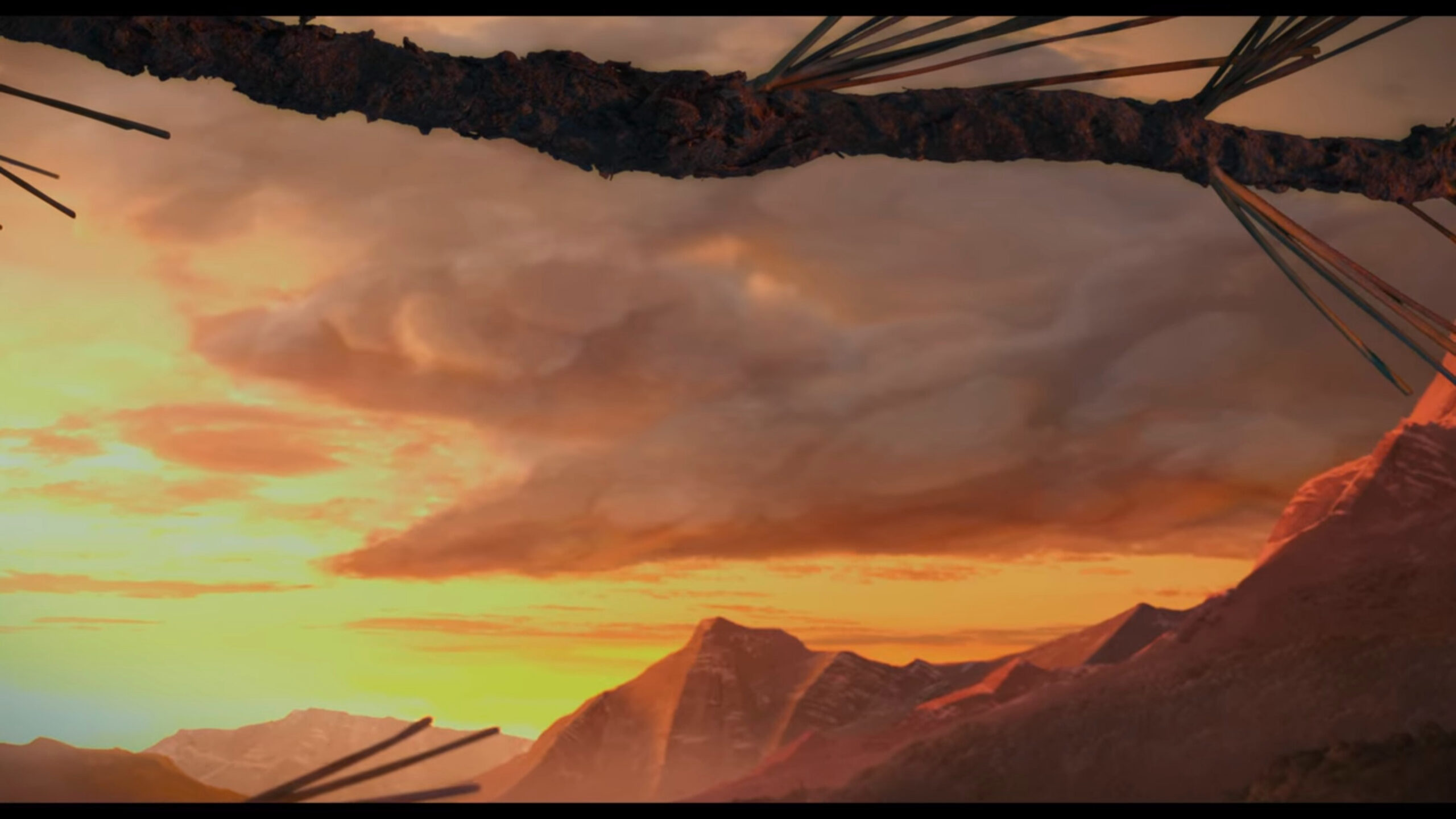
The themes and meaning of Guillermo del Toro’s Pinocchio
Time and experience
Early in Pinocchio, we see the terrific bond between Gepetto and his son Carlo. The two are perfectly in sync and happy together. Then Carlo passes and the Wood Sprite takes pity on Gepetto by bringing Pinocchio to life. What Gepetto wants is for his relationship with Pinocchio to be exactly what it was like with Carlo. Except Pinocchio is brand new to the world and immature to the point of being a burden. He’s selfish and wants instant gratification.
But over the course of the film, Pinocchio grows. Time and experience reshape his behavior. He comes to cherish Gepetto. Care for his friends. Provide for others. This happens not in spite of the negative experiences Pinocchio has but because of them. This culminates with an appreciation for time.
When Pinocchio first dies, the Chimera of Death explains the wooden boy is essentially immortal. He just has to wait for a period of time in the afterlife before returning to his body. But each passing means the time to return takes longer. Initially, this isn’t a big deal. Pinocchio is selfish and believes he has more than enough time. But he eventually realizes the cost of time. Specifically that while he’s in the afterlife, he’s gone from the people who care about him. And could potentially never see them again. He comes to cherish every second he has with those he loves. Which leads us to the theme of…
Death, peace, and acceptance
Pinocchio ends with a stretch of losses. Gepetto passes away in his sleep. Then Sebastian J. Cricket. Then Spazzatura. It’s sad to see the demise of these characters we’ve come to care about. It could be seen as something negative. But del Toro presents these losses as something peaceful. It’s not tragedy. There isn’t pain. Just a transition. And Pinocchio isn’t mad or upset or hurting. Instead, he’s serene. Because he’s grateful for the time he had with everyone. And they felt the same. The love and time they shared allows them to accept death. That’s the gift Pinocchio gave each and every one of them. And I think it’s a lesson to everyone who watches this movie, young and old.
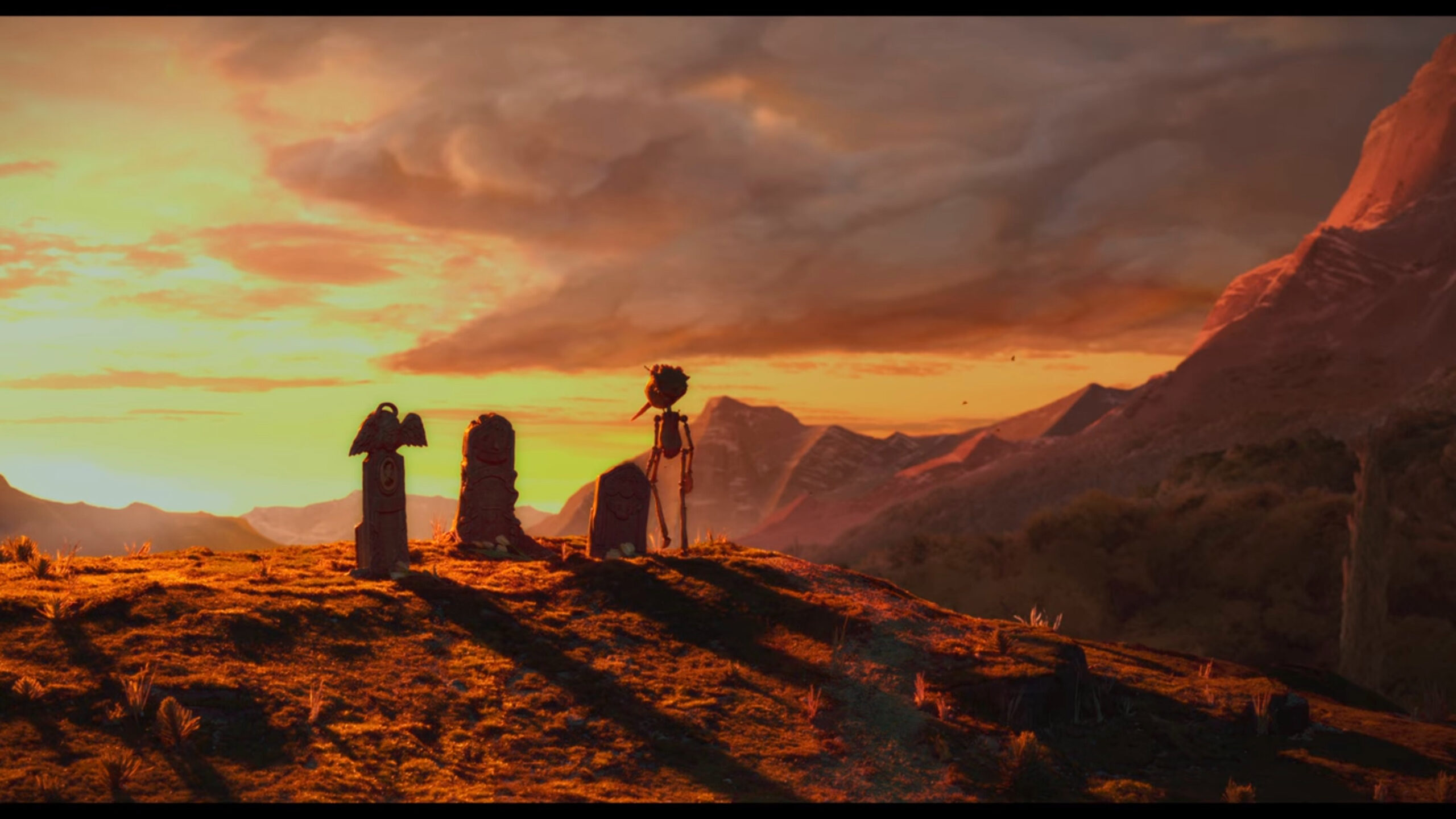
Altruism vs selfishness, and fascism
Pinocchio’s initial behavior is self-centered. He wants hot chocolate because others have hot chocolate. He doesn’t want to go to school, he wants to go off and be a star and receive attention and adoration. In these times, Pinocchio’s at his most awful. As a son, as a friend, as a person. But he comes to appreciate the concept of putting others first. Of friendship and love and benefitting from helping and caring for others. His befriending of Candlewick, Spazzatura, and others has a positive impact on their lives. Both end up helping Pinocchio. With Spazzatura playing an instrumental role in reuniting the wooden lad with his father and helping them escape from the whale.
These themes extend into the film’s setting: Italy during World War I. The politics of the war are more than a backdrop, as they actively affect the lives of our characters. And Italy was very fascist. Fascism is incredibly selfish and self-interested and often relies on an “us vs them” mindset that has, over and over again, proven destructive. It pretty much scoffs at altruism.
It’s very purposeful that one subplot involves Podestà recruiting Pinocchio, Candlewick, and other children into Mussolini’s youth camp, training them for war. The political system of a country can greatly affect the youth of the nation, indoctrinating them into beliefs they may never have had. It’s possible two kind kids like Pinocchio and Candlewick could have been turned into much worse people. Or their lives lost on the battlefield. Larger forces were against Pinocchio growing into a good person. But he persevered. Stay true to what he believed was right. And kindness won the day. Just like Spazzatura deciding to side with Pinocchio rather than continue to follow the awful Count Volpe.
Companionship over selfishness
In Pinocchio, characters are at their happiest when they’re enjoying the company of others and helping one another. They’re at their loneliest when isolated or acting selfishly. Pinocchio wouldn’t have survived certain situations if he hadn’t befriended Candlewick and Spazzatura. Likewise, Candlewick and Spazzatura probably wouldn’t have survived without Pinocchio putting friendship over personal gain.
del Toro extrapolates this conflict of selfishness vs companionship to the larger arena of Italian fascism. That’s because fascism is inherently self-interested and lacking in broader humanity. When Pinocchio is young and only thinking of his own wants, it leads him to Count Volpe’s puppet show. Which leads him directly to Mussolini and recruitment into the Italian army. It’s not a coincidence that the only time Pinocchio has strings on him is when he’s on this path. The few attempts he makes at companionship under Volpe and Podesta infuriates both leaders. They want to turn Pinocchio into something awful. Thankfully, his inherent kindness wins out. Its through his humanity and connection with Candlewick and Spazzatura that Pinocchio regains his freedom and can reconnect with Geppetto.
Why is the movie called Guillermo del Toro’s Pinocchio?
The original book The Adventures of Pinocchio by Carlo Collodi came out in 1883. Since then, there have been nearly two dozen film adaptations. The most popular of which is Disney’s animated Pinocchio from 1940. While there are some fun names and concepts like Pinocchio in Outer Space and Pinocchio 3000, most of these films are simply called Pinocchio. Including ones from 2019 and 2022.
So the title Guillermo del Toro’s Pinocchio is pretty necessary, as it clearly differentiates this version from the rest. del Toro has also become one of the most well-known filmmakers of this era. His name is associated with thoughtful fantasy films that are visually impressive and tend to have a hint of noir about them. His brand is enough to sell this version of Pinocchio as something unique from the rest. It intimates this will be a darker, more haunting version of events. So instead of getting a blonde-hair, blue-eyed fairy like in the Disney version, we have a scary-yet-sweet wood sprite. That stylistic difference is pure del Toro and the reason why the movie is titled how it is.
Important motifs in Guillermo del Toro’s Pinocchio
The pinecone
The very first visual in Pinocchio is the pine cone emerging from the darkness. And the last is of a pinecone falling from the branch. Narration from Sebastian J. Cricket accompanies both. Initially, it’s Sebastian discussing Geppetto mourning Carlo’s passing, which seems to suggest a theme of death and grief. This is confirmed at the end when Sebastian says “What happens, happens. And then we’re gone.” The dialogue is overtop of the last shot of the pinecone and its drop from the branch, out of the frame. It’s a simple dramatization of the way in which people come and go from this world. We grow on the branch, we hang on for as long as possible. Then we go.
Carlo even finds a pinecone that Geppetto buries with the boy, furthering the symbolism of the pinecone as a metaphor for a person’s life.
The hourglass in Death’s kingdom
A conversation regarding human mortality often comes back to the idea of time. And as Guillermo del Toro uses Pinocchio to reflect on the idea of a young person coming to appreciate how limited our time is, the hourglass is an important symbol. At first, Pinocchio doesn’t think much of it, because he believes time is a luxury. But eventually it’s something he realizes he needs every second of.
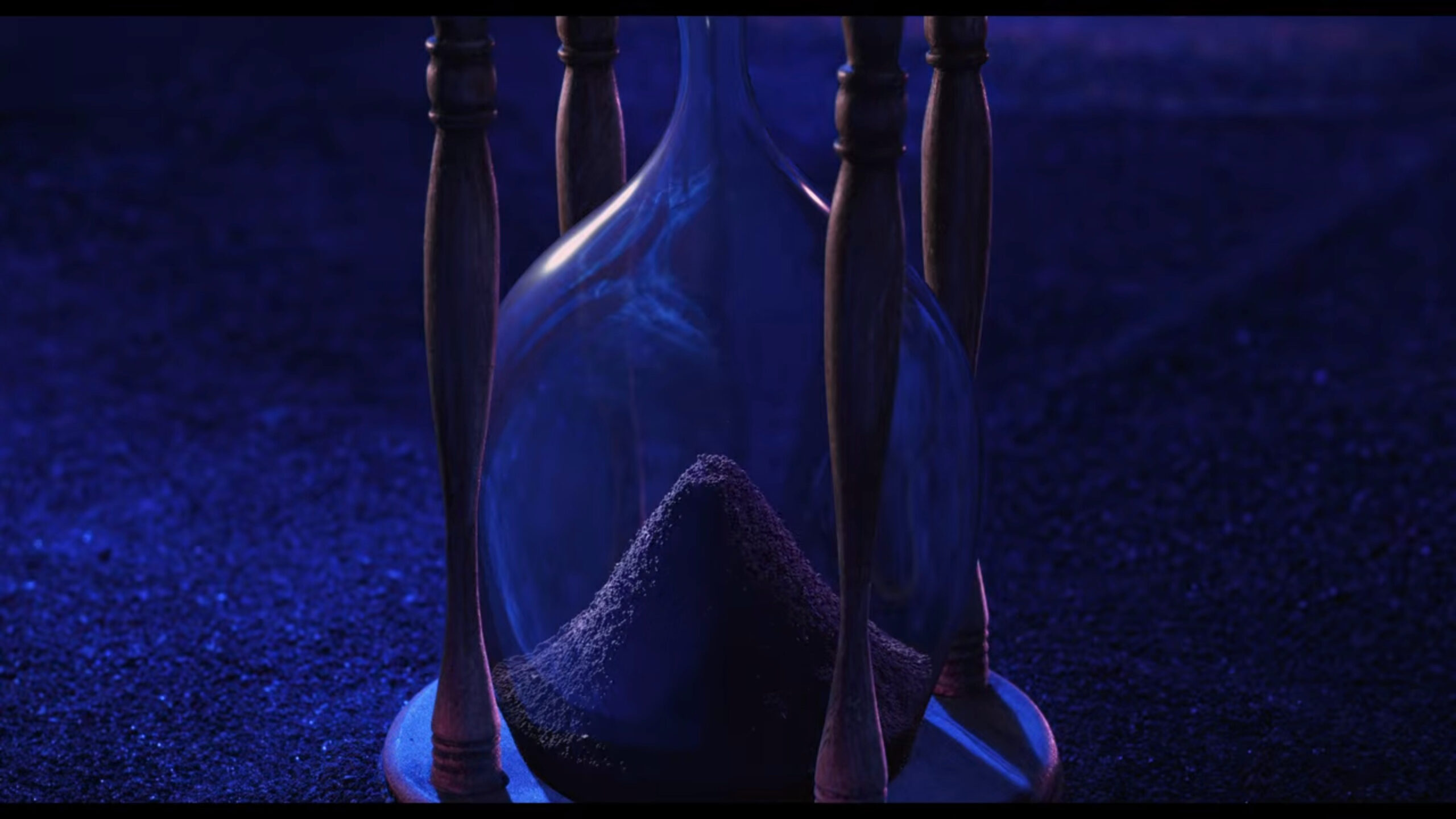
Fascism
Guillermo del Toro sets Pinocchio during the Great War—World War I. del Toro often portrays causes that are interested in the good of the people versus those that are selfish and dictatorial. Pan’s Labyrinth and The Shape of Water are two examples. In Pinocchio, there’s a bit of drama around what kind of person Pinocchio will be. Initially, he’s wild and selfish and only interested in what he wants to do. Which is why he joins Count Volpe’s puppet show—to be a star. That decision leads Pinocchio literally into the army of Mussolini, dictator of Italy. This connects an individual’s decisions to the larger zeitgeist of the country and the larger zeitgeist of a country to an individual’s decisions.
When Pinocchio stops being selfish and begins connecting with others and wanting to make them happy, his life turns around for the better. He escapes the fascist army and begins to make a positive impact on others.
Religion: Christianity vs Paganism
del Toro makes a point to introduce Christianity, then has Carlo die in the church. Which seems like a very pointed statement. Especially since it’s the Wood Sprite who brings Pinocchio to life and is the sister of the Chimera who is literally called “Death”. So it seems del Toro has opted for more of a pagan view of the world. In fact, Pinocchio makes a comparison between himself and the wooden figure of Jesus that those in the church sing to. Later, Volpe hangs Pinocchio on a cross.
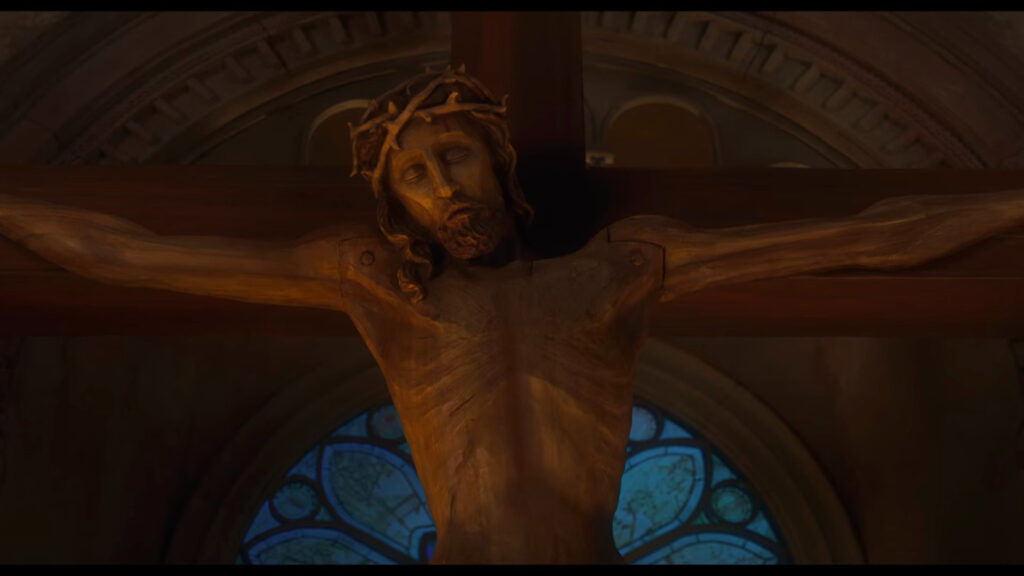
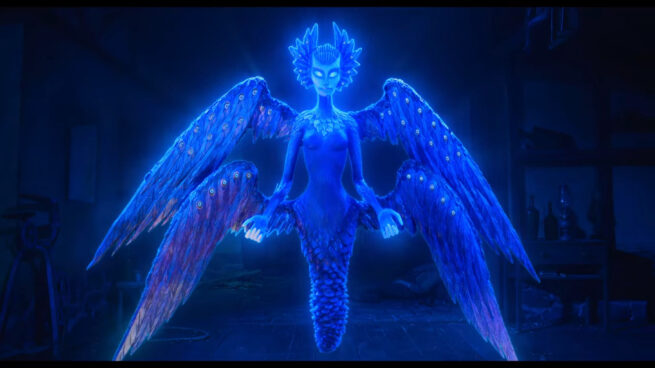
Contrasting childhood and war
This is quick and painful. Early on, we see Carlo and Geppetto living a pretty nice, simple life. Carlo is 10 years old and just a happy kid. But a pair of shots juxtaposes childlike innocence versus the cruelty of the world. The first shot happens while Carlo swings. A cut to a POV shot shows planes in the blue sky. He runs in and excitedly tells Geppetto what he saw. In the next scene, these planes drop bombs on the quiet town, blowing up the church that Carlo happens to be in. Instead of a blue sky, the planes fly through a nighttime thunderstorm. The thunder and lightning captures the tragedy their about to unleash.
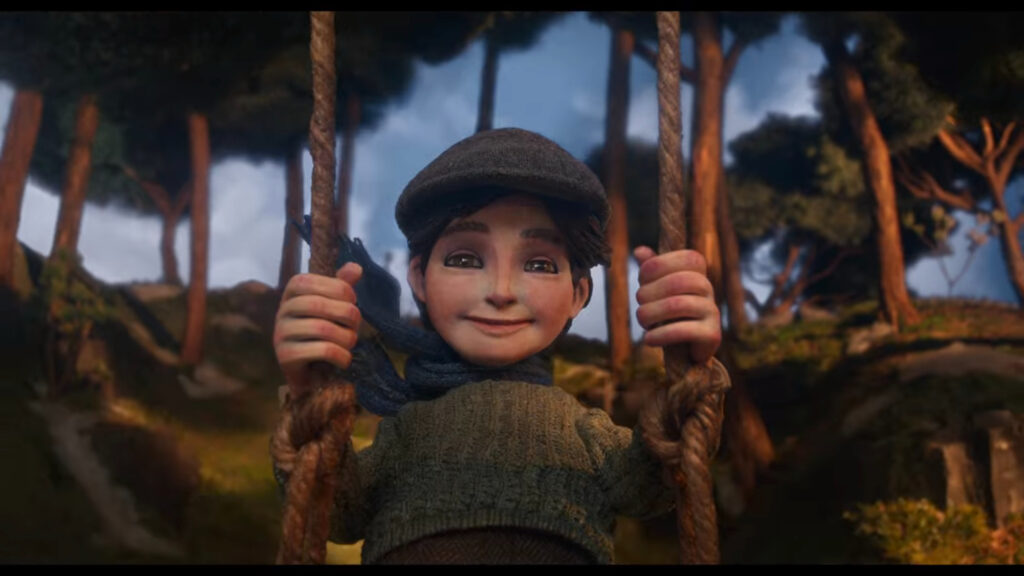
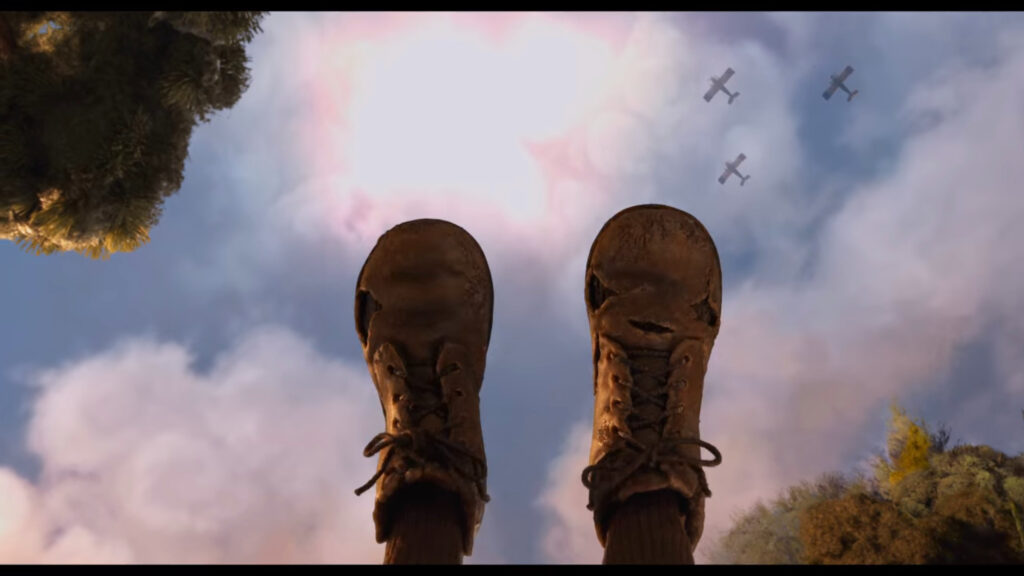
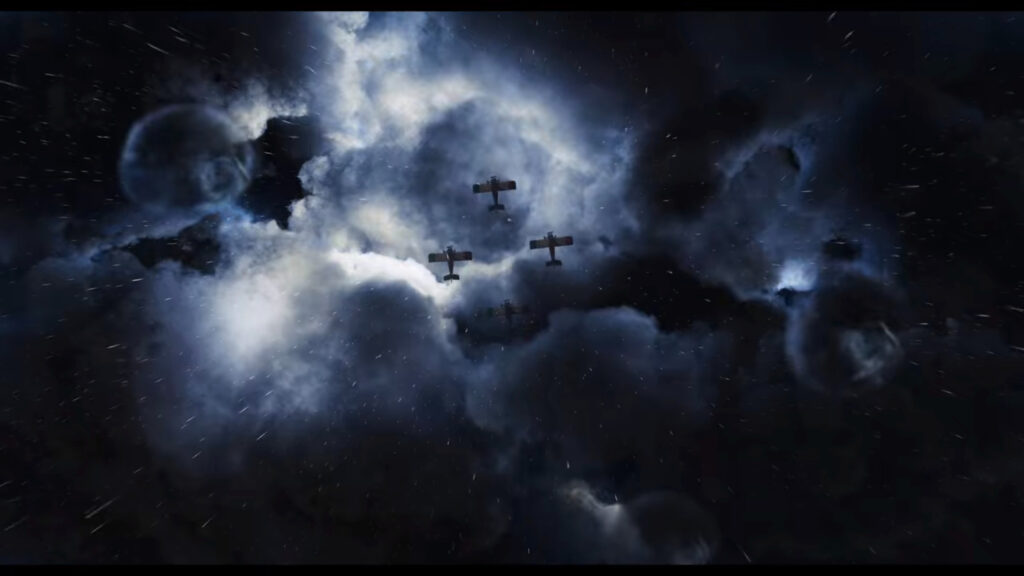
Questions & answers about Guillermo del Toro’s Pinocchio
Why did the Wood Sprite bring Pinocchio to life?
del Toro seems to be making a bit of a statement about Christianity. Geppetto is someone of faith who has helped the church by carving them a new Jesus figure. Yet Carlo dies in a church. And Geppetto spends years lost in grief. But when the Wood Sprite passes by and witnesses Geppetto’s grief, she does something about it. She can’t bring Carlo back to life. But she gives Pinocchio a soul and instructs him to love Geppetto. In the story, the Wood Sprite does it just out of the kindness of her heart. But the reason del Toro has her do it and not the god of a different religion is probably worth a discussion.
What happens to Candlewick?
The last time we see Candlewick is after the bomb drops on the youth army camp. It blows Pinocchio out of the camp and into the mountains. And probably annihilates Podesta. But we have a shot of Candlewick running through the wreckage, calling out for Pinocchio. And that’s it. The movie doesn’t tell us anything more other than Candlewick survived.
What’s interesting is that Candlewick was from the same area. So you’d imagine at some point he would have stopped by Geppetto’s to check in? Unless he and his mother just fled Italy or something. But I imagine there was a scene that just didn’t make the final cut. Or even a sequel where Pinocchio goes out into the world and maybe runs into Candlewick in some city.
Why the emphasis on the pinecone?
The pinecone is del Toro’s succinct way of visualizing the journey of life. We’re born, hang on as long as possible, then fall.
If it’s World War I and Italy, why the Nazi salutes?
Hitler and the Nazis did not invent the salute. It’s originally a Roman thing. Wikipedia has a whole article on it you can check out. For a couple centuries, it had a mostly neutral, classical association. To the point that people in the United States were doing a version of it as part of the Pledge of Allegiance (around the 1890s).
But those running the Fascist Party in 1910s Italy really loved it and it became a prominent part of their iconography. Which led directly to its adoption in Germany. But Germany rebranded it.
Wasn’t the hourglass almost empty when Pinocchio made the deal to return?
It certainly looked that way. But that’s the thing: every second mattered. Pinocchio knew Geppetto was in grave danger. If he waited even 20 seconds longer, he probably wouldn’t have made it back in time to save his papa from drowning. So he sacrificed his immortality.
Is Pinocchio immortal again after Sebastian’s wish?
It kind of seems like that might be the case? Which is why Sebastian, at the end, even asks the question, “Will [Pinocchio] eventually die?” Yet we know Pinocchio can choose to lose his immortality. All he has to do is die and come back early. If he does that, it means his next death is the final one. But, for the time being, it seems he does have his immortality back. What he chooses to do with it is anyone’s guess.
Death did mention to him that human life is precious because it’s so brief. So it’s possible Pinocchio chooses to give up his immortality pretty quickly to have that experience?
Was Mussolini that short?
del Toro presents Mussolini as shorter than everyone else around him. A stumpy child moreso than a bold national leader. Part of this is just del Toro wanting Mussolini to come off as uninspiring as possible. It’s his equivalent to Tarantino’s artistic license with Hitler in Inglorious Basterds. But in real life, Mussolini was on the shorter side, standing between 5’6 and 5’7.
Now it’s your turn
Have more unanswered questions about Guillermo del Toro’s Pinocchio? Are there themes or motifs we missed? Is there more to explain about the ending? Please post your questions and thoughts in the comments section! We’ll do our best to address every one of them. If we like what you have to say, you could become part of our movie guide!

